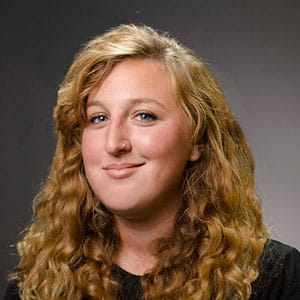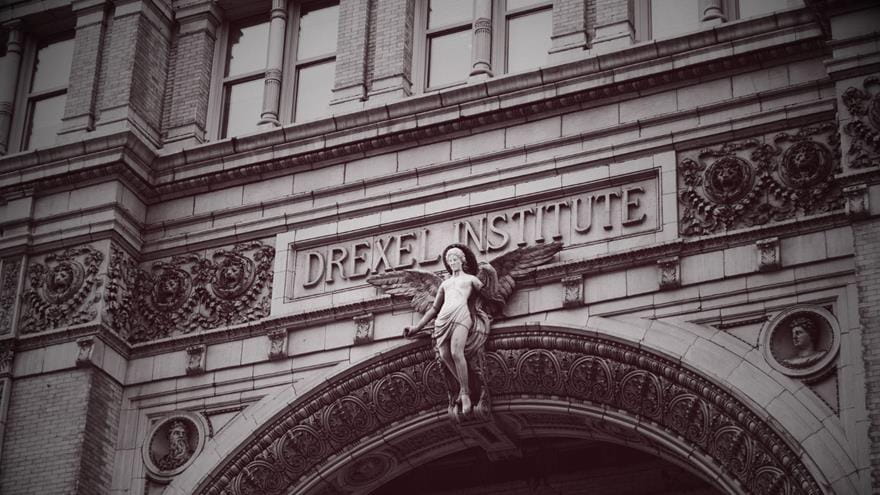Drexel History 102: How Well Do You Know Drexel University?

Another “back-to-school” start of the academic year means another “back-to-school” quiz to see if you know some fun facts about the history and culture of Drexel University. Last year’s inaugural test was so popular that a second installment had to be created!
Answers — and explanatory information — will be revealed at the bottom of the quiz. Good luck!
Drexel History 202 Quiz
1. True or false: Drexel University’s founder, Anthony J. Drexel, was the mentor and business partner of famed financier J. Pierpont “J.P.” Morgan.
a. True
b. False
2. Meinhardt Raabe, who portrayed a Munchkin with a speaking role in “The Wizard of Oz,” received an MBA from Drexel in 1970. While taking classes at night, he worked by day for Oscar Mayer (he was employed there for nearly three decades and famously drove the Weinermobile). What role did he play in the movie?
a. The mayor
b. The coroner
c. A “Lollipop Guild” member
3. A major part of Drexel’s University City Campus used to be part of the nation’s first major toll road (in 1794) and the first transcontinental road for automobiles (in 1913). What is it?
a. Lancaster Walk
b. Market Street between 33rd and 34th streets
c. The area surrounding the Mario the Magnificent statue
4. Over the summer, two Drexel alumni medaled in the 2024 Olympics and Paralympics in what two events?
a. Fencing and para triathalon
b. Rowing and para canoe
c. Rowing and para triathalon
5. True or false: Drexel was the first major American university to offer Wi-Fi on campus.
a. True
b. False
6. ** Bonus question from Simon Ragovin, archives technician in Drexel University Archives: How many Drexel presidents were immigrants?
a. Zero
b. One
c. Two
Answers
1. True or false: Drexel’s founder, financier and philanthropist Anthony J. Drexel, was the mentor and business partner of J. Pierpont “J.P.” Morgan.
Correct answer: A. True.
In 1871, at the urging of his father, 34-year-old J. Pierpont Morgan formally entered a business and mentorship partnership with 45-year-old Anthony J. Drexel, a famed financier and one of the richest men in the country. The Drexel & Co. bank had offices in Philadelphia and Paris and was led by Anthony, who took the reins from his father and the bank’s founder, Francis Martin Drexel. The J. S. Morgan & Co. bank founded by J. Pierpont’s father had offices in New York City and London. The result: Drexel, Morgan & Co., with Anthony as senior partner heading the Philadelphia office and J. Pierpont as junior partner heading the New York office (the space, purchased by Anthony, was used to build 23 Wall St., one of the most famous buildings on Wall Street and the first in New York City to use electricity, thanks to client Thomas Edison).
The partnership was built on mutual respect and trust, and Morgan looked up to Anthony and followed his judgement. Anthony was “the first businessman, other than his father, whom he could admire and respect, and the chemistry generated by that relationship would reshape the future of international finance,” according to Anthony’s biographer, Dan Rottenberg, in “The Man Who Made Wall Street: Anthony J. Drexel and the Rise of Modern Finance.” In the early days of the Drexel-Morgan partnership, Anthony, writing to Morgan’s father, said, “From what I have seen of your son, I think he is a first-class businessman and that you have reason to be proud of him in many ways.”
Morgan attended the opening of the then-Drexel Institute of Art, Science and Industry in 1891, as well as a memorial ceremony held in the same Main Building auditorium three years later honoring Anthony after his death on June 30, 1893. (Morgan also was there as Anthony was laid to rest in the Drexel Mausoleum in Woodlands Cemetery in West Philadelphia.) About two months after Anthony’s death, his daughter sent Morgan a photograph of Anthony as a keepsake; Morgan, who was 56 at the time, wrote back, “I shall value it not only as your gift but on account of my association with him. For he was the best friend I have ever had in every way.”
The Drexel-Morgan partnership lasted for more than two decades; after Anthony’s death, Drexel, Morgan & Co. reverted to its original family banks. The New York and London offices became J. P. Morgan & Co. (today’s JPMorganChase, one of the biggest banks in America) under Morgan. The Drexel & Co. bank continued into the 20th century with different names and partners, eventually dissolving with the disgraced bankruptcy of Drexel Burnham Lambert.
2. Meinhardt Raabe, who portrayed a Munchkin with a speaking role in “The Wizard of Oz,” received an MBA from Drexel in 1970. While taking classes at night, he worked by day for Oscar Mayer (he was employed there for nearly three decades and famously drove the Weinermobile). What role did he play in the movie?
Correct answer: B. The coroner.
Meinhardt Raabe was one of the few Munchkin actors with a speaking part in the beloved movie, telling Dorothy that the Wicked Witch of the West is "really most sincerely dead."
In his autobiography, “Memories of a Munchkin: An Illustrated Walk Down the Yellow Brick Road,” Raabe fondly remembered his days at Drexel, writing, “I decided to further my education and enrolled at the nearby Drexel University, working at Oscar Mayer during the day and taking classes in the evening. In 1970, in under two years, I graduated with a master’s degree in business administration — go, Drexel Dragons!” He also mentioned that he took horticultural classes at Drexel.
He first began working as an accountant at Oscar Mayer in 1937 and took time off to act in “The Wizard of Oz;” he ultimately spent almost 30 years of his life working at the deli meat company, mostly as a spokesman driving the famous giant hot dog automobile across the country. He died at age 94 in 2010.
3. A major part of Drexel’s University City Campus used to be part of the nation’s first major toll road (in 1794) and the first transcontinental road for automobiles (in 1913). What is it?
Correct answer: A. Lancaster Walk.
Lancaster Walk’s intersection with 32nd and Market streets was the site of the original Philadelphia and Lancaster Turnpike, which extends 62 miles west all the way to Lancaster (hence the name). Later, with the advent of cars, it became part of the Lincoln Highway.
It became the pedestrian walkway now known as “Lancaster Walk” in 1974, when the parts of Lancaster Avenue between 32nd and 33rd streets were converted into the sidewalk still used today (a marker is situated at 32nd and Market streets).
4. Over the summer, two Drexel alumni medaled in the Olympics and Paralympics in what two events?
Correct answer: C. Rowing and para triathalon.
Congratulations to Justin Best and Mark Barr! The two Dragons medaled for the first time in their second Olympics and fourth Paralympics, respectively, and have also uniquely competed in multiple sports.
Justin Best, BS business and engineering ’19, won a gold medal as part of the men’s four in rowing — the first time Team USA won in 64 years. He raced in the men’s eights while at Drexel and in the 2020 Olympics, where he placed fourth. While in Paris, he appeared on NBC’s “Today Show” and proposed to Lainey Duncan, BS fashion/apparel design ’20. The two Dragons met in high school. Best works as an analyst at a boutique investment firm in San Francisco, California.
Mark Barr, BSN ’11, won a bronze medal in the para triathlon (swimming, running and biking). This was Barr's fourth time in the Paralympic Games and third sport; he competed in a number of swimming events in 2004 and 2008, taking fourth place in the men's 4x100m freestyle relay in 2004, and in 2016 he placed fourth in the sprint triathlon. In 2019, he received the ESPY for Best Male Athlete with a Disability. Barr works as an anesthesiologist in Houston, Texas.
5. True or false: Drexel was the first major American university to offer wireless Wi-Fi on campus.
Correct answer: A. True.
Drexel make big strides for its technological legacy in 2000 with the creation of its wireless service (called DragonFly then; it’s DragonFly3 now). In the ‘90s, Drexel was an early adaptor in creating an online university, streaming Commencement and creating a user-friendly website-development system. A decade before that, Drexel was the first to require all students have a personal computer (and, consequently, that faculty could use computers to teach) in 1984, because of a one-of-a-kind partnership with Apple.
6. ** Bonus question from Simon Ragovin, archives technician in Drexel University Archives: How many Drexel presidents were immigrants?
Correct answer: C. 2.
The first and second-to-last Drexel presidents were born in a different country.
James A. MacAlister (1840–1913) was Drexel’s first president and longest-serving president, leading for 22 years from the school’s opening in 1891 until he resigned in poor health, dying shortly afterwards in 1913. He was born in Scotland and emigrated in 1854, according to the 1900 census, and lived in Wisconsin. After receiving his law degree, he later became regent of Wisconsin’s state normal schools (training colleges for teachers) and the first superintendent of Milwaukee's public school system and, later, Philadelphia’s public school district. An advocate of vocational and manual training, he was appointed the first president of the then-Drexel Institute of Art, Science and Industry, which was started to provide vocational training and evening education for students regardless of race, gender, religion or economic status. The year before the Institute opened, MacAlister prepared the new Main Building for occupancy and used the founder’s $1 million donation (more than $34 million in today’s currency) to purchase objects for what is now the Drexel Founding Collection, the University’s flagship art collection. He presided over the institution as it grew from 70 to 500 students. He is the namesake of today’s MacAlister Hall on the University City Campus.
Constantine N. Papadakis (1946–2009), who lead Drexel from 1995 until his death in 2009, was born in Greece and came to the United States for his civil engineering education, receiving a master’s degree the University of Cincinnati and a doctorate from the University of Michigan. Formerly the head of Colorado State University’s civil engineering department and dean of University of Cincinnati's College of Engineering, Papadakis became president of Drexel, which was struggling after leadership changes, financial challenges and decreasing enrollment. Among his many accomplishments included in his Drexel obituary, Papadakis’s attention to order and structure brought increased student enrollment and faculty size, acquired the bankrupt Allegheny University of the Health Sciences to create today’s College of Medicine, College of Nursing and Health Professions and Dornsife School of Public Health, started today’s School of Education and Kline School of Law, and increased the University’s urban, academic and technological reputation. During his 14-year tenure, he was the only Greek-born president among 2,900 presidents of four-year institutions of higher education in America. He is the namesake of today’s Papadakis Integrated Sciences Building (PISB) on Drexel's University City Campus.
Of note: Drexel’s founder, Anthony J. Drexel, was himself the son of an immigrant, Francis Martin Drexel, who reached America after escaping a Napoleonic invasion of his home in the Tyrol region of Austria. The elder Drexel spoke multiple languages and used his international know-how to set up the famous Drexel bank that first got its start in trading currencies — attributes shaped by his international experience that influenced his son. Drexel is unique as an American university with founding ties to Austria; in recent years, the University has made connections to Francis Martin’s birthplace in Dornbirn, Austria, including a co-op in the city’s archives department, Drexel-led trips and visits with Dornbirn’s government and local university.
Drexel News is produced by
University Marketing and Communications.

